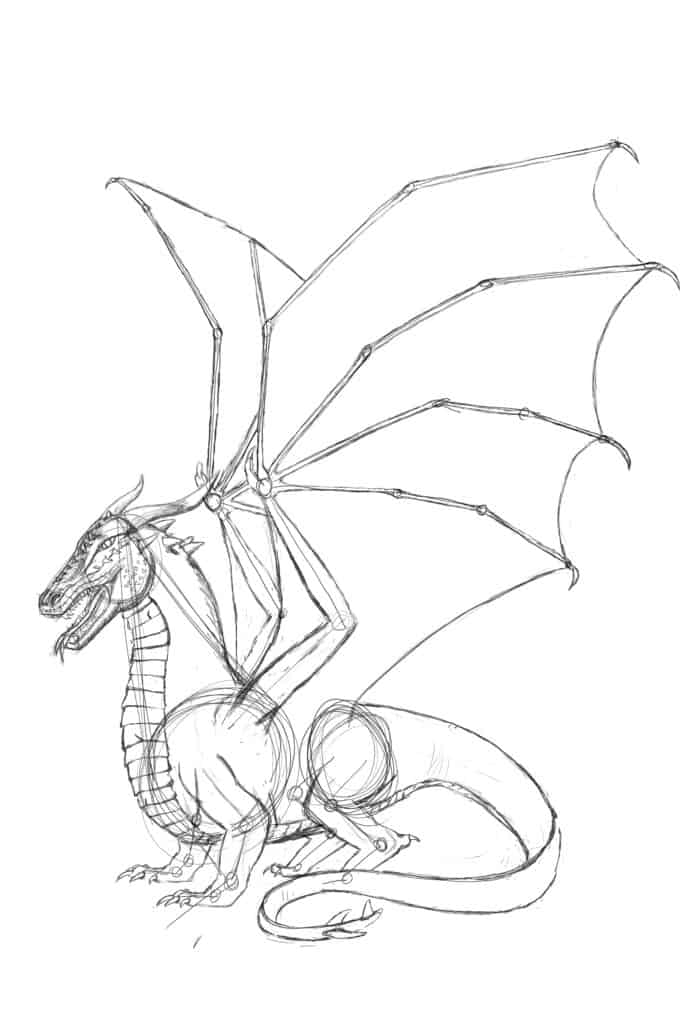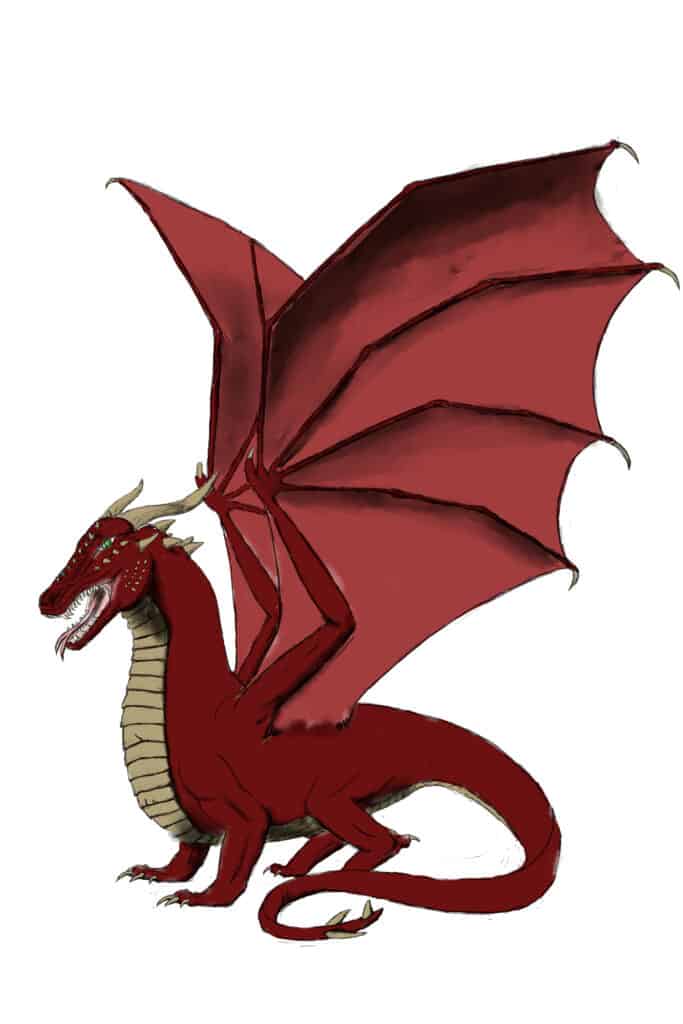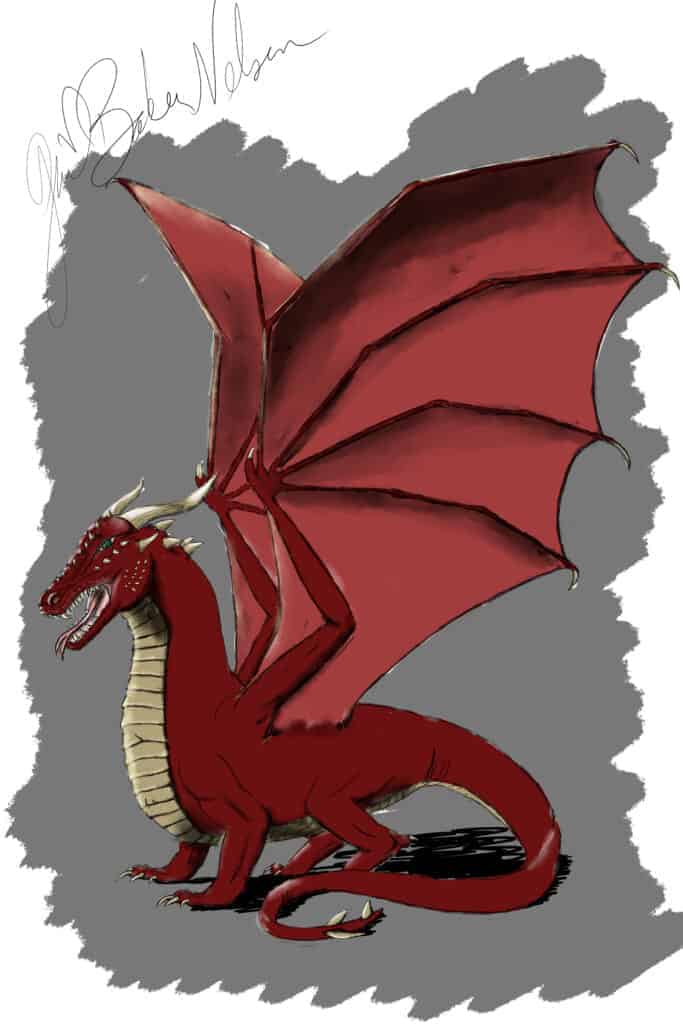Dragons are hard to draw. Let's learn how to draw a dragon in 6 easy steps. Learning to draw a dragon means you must become comfortable going off the beaten path because they have no real-world equivalent. Instead, there are many types of dragons, all of which are rooted in the mythology of a given culture. For example, dragons of the east are more serpentine or lizard-like and don't always have wings. However, they generally have lots of horns. On the other hand, dragons of the west look like a T-Rex, a crocodile, and a bat mixed up in a genetics lab.
It's a good idea to research the various forms to come up with one that you like. For example, I tend to like the western dragons a little more because they remind me of those in books like The Hobbit.
You'll need a few supplies and a lot of patience; however, when you're done, I hope you've created something you love.
If you're using Photoshop or another art app on your computer, I strongly recommend also using a graphics tablet. The drawing stylus they include is much more natural than drawing with your mouse. For my computer illustrations, I use the Huion HS611. It's fairly reasonably priced and allows you to draw more easily.
Supplies
| Supplies | Type Needed |
|---|---|
| Blending with your finger or a Q-tip are good options, but I feel like these give me more control over what I'm doing. | Consider using thicker paper than standard notebook paper. Watercolor paper and Bristol are both excellent choices. |
| Drawing pencils | Try to find a few different hardness pencils, such as 2H, HB, 2B, and 4B; they're perfect for beginners. Don't spend a ton on these yet; unless you've been drawing for a while, you may be unable to tell the difference between a $5 pencil and a 50-cent pencil. |
| Watercolor or colored pencils | I used red and dark red/burgundy, bronze, green, and ivory; however, you can choose whichever colors suit your preferences. |
| Erasers | Please don't skimp on erasers; getting decent ones only costs a few dollars. My favorites are the putty type you can mold and a standard rubber eraser. |
| Blending stumps or blending pencils | Blending with your finger or a q-tip are good options, but I feel like these give me more control over what I'm doing. |
| White gel pen or white pencil | It may sound like a waste if you're not drawing on dark paper, but these help finish touches like highlights. |
| Watercolor paint brushes | Smaller projects like this need small round watercolor brushes. |
1. Lay the Dragon Drawing Foundation

Start by lightly sketching a few basic shapes— a large circle for the body, and a smaller one for the rump. Then, add a triangle for the head.
I modified the shapes we used for the horse and the unicorn for the snout. Instead of one square with two lines connecting to the head, I drew two of them to represent an open mouth.
Yes, I know, I use these for every drawing tutorial I've done but it's because they work. There was a time when I would do anything to avoid using them because I thought it was silly. After all, if I were a good enough artist, why should I need them?
It's simple: You use them because they make you a better artist.

Next, add legs, a tail, and wings.
The circles represent joints that you would see in the animal. The tail is like a snake because you won't see the joints; it just curves around.
A note about the wings: Wings are hard to draw; I based these on the idea of a bat's wings. They're modified arms with elongated fingers. You could just as easily base your dragon's wings on that of a bird, but the principle is the same.
Digital artists: Create a couple of layers. One layer is for the body, and another for the legs, tail, and wings.
Paper artists: Sketch lightly! You'll have to erase or blend these into the final outline.
2. Create a Rough Outline

It's time to sketch that outline. Take your time! You do not have to include all the horns on the dragon. They're purely optional and if they cause frustration, skip them. Remember that this is your creation, not mine or anyone else's.
Your rough sketch doesn't have to include much detail. I have more detail in mine because I had a relatively clear idea of what I wanted, and I sometimes get carried away in the earlier stages of a drawing. However, if you have any doubt about how the finished product needs to look, leave out finer details until later in the process.

Now, take a few moments to redraw the outline and remove all the messy basic shapes. Pay attention to the wingtips with the claws — again, it's okay to leave extras out — and add only as much detail as you're comfortable adding because you still need to color and shade this fantastic beast.
Add the belly scales because I can't imagine a dragon without some reptilian belly scales.
A note on preferences: If you want to leave your dragon as a sketch, feel free to do so. There's no reason to color it in if you enjoy how it looks as a sketch. Skip the color steps and go to the shading and highlights.
Digital artists: Use multiple layers. For my drawing, I used a layer each for the head, body, legs, and wings. It allows you to remove things you don't like without reworking the whole thing.
Paper artists: Again, sketch lightly if you're using paper.
3. What Color Dragon Do You Want?

I had a hard time deciding between a green or a blue dragon. Maybe purple. In the end, red won the day. This dragon became dark red because I thought it looked good with the green; I had already colored the eye. When I started this, I got a little ahead of myself and colored the eye green, even though, in reality, it probably should have waited.
My impatience aside, the green looks pretty good, and while you're at it, color the mouth pale pink. Then, make its tongue a little darker, and add a hint of pink to the edges of the eye where the tear ducts would be located.
Start your coloring gently, then layer on more color until you're satisfied with it. As you work, you can leave some areas, like the top of its head and tail, or maybe its knees, a little lighter than the underside of its belly or legs. It may make highlighting easier later. Also, be careful around the horns and claws. You don't want to color over them accidentally and have to fix them later.

Dragon wings are often depicted as being bat-like. Bat wings are made from skin stretched out between their elongated fingers. It makes them thin and somewhat transparent, although they'd be much larger and presumably thicker-skinned in a dragon. Keeping that in mind, even if it were the same basic color as the body, dragon wings might have a bit of transparency or perhaps a slight color shift. It's just more diluted when they're folded.
Color carefully around the bones, and blend the two colors at the base of the wings. If you blend the darker color up toward the lighter color, it'll look like it's stretching out.

Take your time with the horns because they're small and easy to color too far outside the lines. Pick a color you enjoy because you're in charge of its final appearance when you draw a mythical creature. Be creative, and have fun!
Digital artists: Each color needs to have its own layer. Save yourself the hassle of redoing things if you decide you don't like the way it looks.
Paper artists: Begin gently, and add color as you feel it needs more. Don't get too hung up on perfection; remember that sometimes, less is more.
4. Shading Your Dragon Drawing

To shade your dragon drawing properly, keep the light source in mind. In this case, it's coming from the top left of the dragon. Shadows are the flip side of light; more accurately, they're the absence of light. They only exist where enough light exists to cast shadows. The stronger the light source, the deeper the shadows, so decide now how dark the shadows in your drawing will become.
Think about real-world animals and how their muscles shape their bodies. Muscles pull but don't push. For example, the biceps pull the forearm (or foreleg) inwards, while the triceps pull it out. This is why a push-up works one set of muscles, and a pull-up works an entirely different group of muscles. Consider this when you add shading to the legs.
Take a look at a few different animals or even people in active poses and ask yourself these questions:
- What are their muscles doing?
- How does that affect the shape?
- How do the shadows and light look?
Now that you have a clearer mental picture of where the shading belongs, it's time to get to work. If it's difficult to picture the light, draw diagonal lines from the light in the direction that it's heading. Either do it in a separate layer or light enough that you can erase it easily.
Add shadows to the space under and behind its legs, lower and back sides of its tail, and under its chin where the light is casting a shadow from its huge, toothy mouth. Soften the edges of the shadows, and use a blending stump or Photoshop blender tool to drag the edges up and around a little to create the shape you want to see.
Create sharper-edged shadows around the edges of the horns, claws, teeth, and belly scales. They're harder surfaces, so the shadows need to indicate the hardness by not blending in as much.
Digital artists: Create a new layer for the shadows, and set it to multiply. As you add shadows, they'll build and darken the color behind the layer without completely obliterating it.
Paper artists: Instead of black, try a darker shade or heavier layer of whatever color it is. Sometimes, it looks more natural than a standard black shadow. However, black is probably the right color to use if it's a very deep shadow. Then, make any shadows that touch the ground black/gray.
5. Creating Highlights that Make Your Dragon Drawing Pop

Highlights are where the light is strongest, and the parts of your dragon drawing closest to the light will have stronger highlights. Why didn't we do the highlight portion first? I suppose you could, but I've always done it this way, and it works. I've done the highlights first in a few drawings and always seem to have to re-apply them because something got messed up. It may be just me, but I figure it pays to do things in a way that gives me confidence that it will work. I don't have the patience to do otherwise.
Now, let's get to work on those highlights. Remember, they're strongest in places where the light touches first, so that gives the top of its head, leading edges of wings, horns on its forehead, and, to a slightly lesser degree, the chest the brightest highlights.
Soften the edges where it's either a softer highlight, like on its hide or wings. Don't soften them as much on hard surfaces.
Other highlighted areas:
- Nostril edges
- Thin highlight edge along the far edges of its snout
- Claws
- Front edges of its legs
Digital artists: Just as we did for the other steps, create a new layer for the highlights. It's hard to fix things if you haven't created layers when you discover a mistake. You can use either white or lighter shades of the colors you used for your dragon drawing.
Paper artists: Get ready to use your moldable eraser, gel pen, or white pencil. Start by using the moldable eraser to lift away the color in areas that need highlights. Then, on the horns and claws, use your white pencil or gel pen to add more pronounced, hard-edged highlights.
6. Finishing Your Masterpiece

Before you do anything else, stop! If you've been working on this dragon for a few hours or days, your eyes need a break. You'll miss details that you would otherwise spot unless you take a break. So, walk away from it for at least a day.
After you've let it sit for a day or two, open the file or pull the drawing out again. You may see something that doesn't look quite right or that looks a little flat. If so, take a moment to address it.
In mine, I realized that I had neglected the fold in the skin right behind its rump where the tail starts, so I added a few short vertical lines to that spot. I also added a ground shadow and background color.
Now, step back from your dragon drawing and look at it from a distance. If you're on a computer, zoom out. Do you see anything else that needs to be adjusted?
And there you have it how to draw a dragon in 6 easy steps.